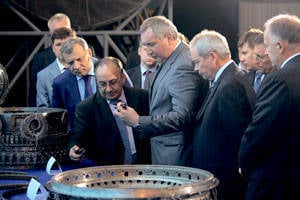Engine PD-14 - the future of the Russian aviation industry
The objective of the PD-14 Engine for MS-21 aircraft is to create a family of commercial engines for short and medium-haul aircraft with a seating capacity from 130 to 180 seats. The engines of the prospective family must compete with their foreign counterparts in technical characteristics and economic efficiency.
The most important task of the project is to eliminate the technological lag of Russia in the gas turbine engine-building industry in the shortest period. In addition, in the course of its implementation the tasks are solved:
The basis of cooperation
 The idea of creating a new generation of Russian aviation engine was born in the depths of the engine-building design bureau of Aviadvigatel OJSC at the beginning of the 2000s.
The idea of creating a new generation of Russian aviation engine was born in the depths of the engine-building design bureau of Aviadvigatel OJSC at the beginning of the 2000s.For a long time and carefully studied the development trends and the technical level of the world leaders in the engine industry, the aircraft and air transportation market was analyzed to select the correct thrust range of the future engine. Given the aggressive expansion of foreign-made aircraft to the Russian market, the new engine must not only surpass future-looking foreign counterparts in its technical characteristics, but also ensure the competitiveness of new Russian aircraft in terms of economy, environmental performance, and cost of flight hours. And for a serial manufacturer - an acceptable cost of production. Given the technological lag of the aviation industry from the world level of the first decade of the 2000-s, it is not an easy task.
Starting to develop a new engine, we understood that it was impossible to create a competitive product by using a single design school. Therefore, initially the project was conceived as the integration of the strengths of all engine-building enterprises and research institutes of the Russian Federation.
The main business idea of the project is to develop a domestic modern efficient gas generator of a high degree of technical excellence with parameters that allow it to create a family of engines of various capacities that can be installed on various types of aircraft and used in ground installations - gas pumping units and power plants. The gas generator is the most complex and highly stressed engine assembly, which determines its competitiveness and manufacturing cost. The unification of this unit allows it to be mass produced for the production of engines of various applications and significantly reduce the cost of each of the future modifications. In addition, materials, technology design, testing, refinement and production of the gas generator can not be imported from abroad, because they are always the protected know-how of the country, the secret behind seven seals, since they significantly determine the place of the state in the world table of ranks ( this is why the production of the hot part of the SAM146 engine is concentrated in France).
 The idea was supported by all engine-building enterprises and aviation research institutes. In 2006, a protocol of intent on the joint implementation of a project to create a family of new generation aviation engines for civil aviation based on a unified gas generator was signed by Aviadvigatel OJSC, PMZ OJSC, CIAM, Salyut, NPO Saturn, UMPO, NPP Motor ", JSC" MPP them. Chernysheva ", JSC" Klimov ". Business leaders decided to work together to develop a competitive engine in order to ensure conditions for the Russian aviation industry to return Russia to the status of an aviation power. This document laid the foundation for future cooperation.
The idea was supported by all engine-building enterprises and aviation research institutes. In 2006, a protocol of intent on the joint implementation of a project to create a family of new generation aviation engines for civil aviation based on a unified gas generator was signed by Aviadvigatel OJSC, PMZ OJSC, CIAM, Salyut, NPO Saturn, UMPO, NPP Motor ", JSC" MPP them. Chernysheva ", JSC" Klimov ". Business leaders decided to work together to develop a competitive engine in order to ensure conditions for the Russian aviation industry to return Russia to the status of an aviation power. This document laid the foundation for future cooperation.Engine initiative was supported by the Russian government. In the year 2008, after the nationalization of engine-building assets, state financing of the base engine project began, which became known as PD-14. The lead contractor of the project and the recipient of budgetary funds was OAO UK UDC, the lead developer was the Perm Design Bureau of Aviadvigatel OJSC. In the development of the engine involved:
Key milestones
PD-14 is a turbojet dual circuit engine 14 tons, designed for use on promising short-range and medium-haul MS-2017 aircraft on 21 – 130 passenger seats. Work on the creation of the PD-180 engine is being carried out synchronously with work on the creation of the MS-14 aircraft developed by the United Aircraft Building Corporation at the expense of the budget of the Russian Federation.
 The project "PD-14 Engine for MS-21 Aircraft" is being implemented using Gate technology. After each development stage, Aviadvigatel OJSC organizes an examination of the results achieved by engine engineers, scientists, aircraft builders, the state, and customers - the so-called control lines. Highly qualified specialists from industry departments, research institutes, UAC, UEC are involved as experts. This makes it possible to consolidate and take into account the views of all interested parties, avoid mistakes, make timely adjustments to the engine design and organization of the development process, thereby minimizing financial costs and shortening the time frame. The solution of the project tasks is carried out in the Business & Technical complex ("Business and technical part").
The project "PD-14 Engine for MS-21 Aircraft" is being implemented using Gate technology. After each development stage, Aviadvigatel OJSC organizes an examination of the results achieved by engine engineers, scientists, aircraft builders, the state, and customers - the so-called control lines. Highly qualified specialists from industry departments, research institutes, UAC, UEC are involved as experts. This makes it possible to consolidate and take into account the views of all interested parties, avoid mistakes, make timely adjustments to the engine design and organization of the development process, thereby minimizing financial costs and shortening the time frame. The solution of the project tasks is carried out in the Business & Technical complex ("Business and technical part").For the first time, engine development is carried out “at a given cost price” - cost parameters are taken into account when determining the engine design, production technology and maintenance technologies.
When developing an engine design, the emphasis was placed on time-tested classical design solutions, which, in combination with the use of modern design and testing technologies, provide qualitatively new characteristics of the finished product. New Russian titanium and nickel superalloys are widely used in the engine, allowing to provide the necessary parameters. Compared with the best Russian turbofan engines (SaM146, PS-90A, PS-90A2) and foreign analogues (CFM56, V2500), a qualitative leap in the increase of the basic parameters was achieved, ensuring a reduction in the specific fuel consumption of the PD-14 engine on 12-XNXX.
The use of polymer composite materials allows the introduction of modern noise suppression technology and reduce engine weight. The proportion of composite materials in the design of the engine nacelle reaches 60 – 70 percent. In total, the engine uses about twenty items of new materials.
16 key technologies that provide quality manufacturing and high engine production are highlighted. These technologies, unfortunately, were absent in the engine industry of the Russian Federation. Today, enterprises participating in the project are successfully developing and implementing these technologies, which in itself is a big step forward for the innovative development of the country and the creation of high-tech jobs in Russia.
In 2012, the engine technology demonstrator (DDT) passed a bench test complex. Their main goal - to demonstrate the readiness of engineered design and technological solutions - has been successfully achieved. DDT showed good results in thermodynamics, acoustics and emissions - better than those of modern analogues, showed the effectiveness of the technologies used.
To confirm the airworthiness of the PD-14, special qualification of materials (semi-finished products) used in the engine is carried out. A databank of characteristics of materials is being formed, confirming that these materials have the required level of structural strength. Material samples are tested in new, modern, accredited AR IAC laboratories of Aviadvigatel OJSC, CIAM and VIAM. To reduce the time required to test materials, Aviadvigatel has built a unique robotized sample-making complex in the world.

When developing the PD-14 engine and introducing new technologies, the interests of future customers, those who will be engaged in its operation, are taken into account.
Purposeful work to reduce production costs, the cost of maintenance and repair, ensure the stability of the characteristics and high reliability of the engine, its fuel efficiency, reduce weight, noise and the emission of harmful substances ensures low engine life cycle costs.
When implementing the project, in parallel with the engine design, the issues of creating a modern and customer-friendly after-sales service system are addressed - as closely as possible to the customer's repair and technical base, convenient logistic schemes, providing the best guarantees and service — all that due to the relatively small number of aircraft in operation domestic production is completely absent and causes fair complaints of air carriers.
The results achieved so far give us confidence that PD-14 will be competitive not only in technical characteristics, but also in the cost of flight hour.
In the spring of 2013, a significant event for the project took place - an application was submitted to the IAC AR to obtain a PD-14 engine type certificate, and at the end of the year the project will enter the stage of international certification in EАSА.
In the 2014 year, tests of the PD-14 engine will be launched at the Il-76 flying laboratory at the LII named after Gromov.
The implementation of the project “Engine PD-14 for MC-21” on the basis of extensive cooperation of engine-building enterprises and scientific research institutes allows to ensure high efficiency in the use of budget funds. State money is invested not only in the development of a specific high-tech modern product - the PD-14 engine, but also in the actual introduction of modern design, testing and production technologies, which can significantly overcome the technological lag of the domestic aviation industry and create the basis for its further development. Firstly, there is a guarantee that these technologies will be really used in the production of the popular competitive product - PD-14 engine. Secondly, budget money is invested in the strengths of enterprises. This minimizes their risks of mastering new competencies - based on their practical experience, they can prevent possible mistakes and failures. Thirdly, since participation in cooperation “distracts” only a part of the production capacities of enterprises, retaining their ability to receive revenues from the sale of other products, not a single cooperative is threatened with a significant loss of profit at the stage of primary, always very limited in terms of sales of engines and airplanes .
Such a distribution of risks between private business and the state is optimal for achieving the goals of both parties. The change in the existing structure of the project will inevitably increase the risks of the state once again to no avail losing billions in funds already invested in the project.
I am confident that the implementation of the project for the creation of PD-14 will be an example of the successful development of high-tech production based on domestic engineering developments and inventions.
Creating a family of promising engines on the basis of a unified gas generator is a brilliant opportunity for Russia to return domestic engine building to the world level, and for the United Engine Building Corporation a chance to gain a foothold among the world's largest manufacturers of gas turbine equipment.
Information